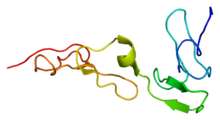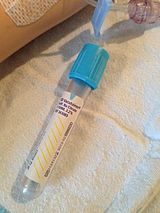Protein S deficiency
| Protein S deficiency | |
|---|---|
 | |
| Protein S structure | |
| Specialty | Hematology |
| Symptoms | Purpura fulminans[1] |
| Causes | Vitamin K deficiency[1] |
| Diagnostic method | Coagulation test[1] |
| Treatment | Heparin, Warfarin[2] |
Protein S deficiency is a disorder associated with increased risk of venous thrombosis.[1] Protein S, a vitamin K-dependent physiological anticoagulant, acts as a nonenzymatic cofactor to activate protein C in the degradation of factor Va and factor VIIIa.[3]
Decreased (antigen) levels or impaired function of protein S leads to decreased degradation of
Signs and symptoms
Among the possible presentation of protein S deficiency are:[1][2][5][4]
- Thrombosis of lower extremities
- Superficial thrombophlebitis
- Redness in affected area
- Purpura fulminans
- Pulmonary embolism
- Stroke (in children)
Cause

In terms of the cause of protein S deficiency it can be in inherited via
Pathophysiology
In regards to the mechanism of protein S deficiency, Protein S is made in
Mutations in this condition change
Diagnosis

The diagnosis for deficiency of protein S can be done via reviewing family history of condition and genetic testing, as well as the following:[1][11][12]
- Protein S antigen test
- Coagulation test (prothrombin time test)
- Thrombotic diseaseinvestigation
- Factor V Leiden test
Differential diagnosis
Among the possibilities for differential diagnosis of protein S deficiency are-
Types
There are three types of hereditary protein S deficiency:[2][6]
- Type I – decreased protein S activity: decreased total protein S levels, as well as decreased free protein S levels
- Type II – decreased in regards to the cofactor activity of the protein
- Type III – decreased protein S activity: decreased free protein S levels (normal total protein S levels)
Treatment

In terms of treatment for protein S deficiency the following are consistent with the management (and administration of) individuals with this condition (the prognosis for inherited
- Unfractionated heparin (w/ warfarin)
- LMWH/Low molecular weight heparin
- Dabigatran
- Direct Factor XaInhibitors
- Graduated compressed stocking
- High degree of prophylaxis
References
- ^ a b c d e f g h "Protein S Deficiency. Learn about Protein S Deficiency | Patient". Patient. Retrieved 2016-10-16.
- ^ a b c d e f "Protein S Deficiency: Background, Pathophysiology, Epidemiology". 2016-05-02.
{{cite journal}}: Cite journal requires|journal=(help) - ^ "Protein S: Reference Range, Collection and Panels, Interpretation". 2016-06-01.
{{cite journal}}: Cite journal requires|journal=(help) - ^ a b c "Protein S Deficiency". Cleveland Clinic. Retrieved 7 February 2023.
- ^ "Congenital protein C or S deficiency: MedlinePlus Medical Encyclopedia". medlineplus.gov. Retrieved 16 October 2016.
- ^ a b c Reference, Genetics Home. "PROS1 gene". Genetics Home Reference. Retrieved 16 October 2016.
- ^ Reference, Genetics Home. "protein S deficiency". Genetics Home Reference. Retrieved 16 October 2016.
- ^ "Endothelial Cells, Volume 1, 1988, p158, By Una S." Retrieved 24 January 2019.
- PMID 19729839.
- ^ S2CID 26719614.
- ^ "Protein S blood test: MedlinePlus Medical Encyclopedia". medlineplus.gov. Retrieved 16 October 2016.
- ^ "Protein S deficiency - Conditions - GTR - NCBI". www.ncbi.nlm.nih.gov. Retrieved 16 October 2016.
Further reading
- ten Kate M, Mulder R, Platteel M, Brouwer J, van der Steege G, van der Meer J (2006). "Identification of a novel PROS1 c.1113T→GG frameshift mutation in a family with mixed type I/type III protein S deficiency". Haematologica. 91 (8): 1151–2. PMID 16885060.
- García de Frutos, Pablo; Fuentes-Prior, Pablo; Hurtado, Begoña; Sala, Núria (17 October 2007). "Molecular basis of protein S deficiency". Thrombosis and Haemostasis. 98 (3): 543–56. S2CID 17274778. Archived from the originalon 18 October 2016. Retrieved 16 October 2016.
- Wypasek, Ewa; Undas, Anetta (1 August 2016). "Protein C and protein S deficiency - practical diagnostic issues". Advances in Clinical and Experimental Medicine. 22 (4): 459–467. PMID 23986205.
External links
- Protein S deficiency at Curlie
